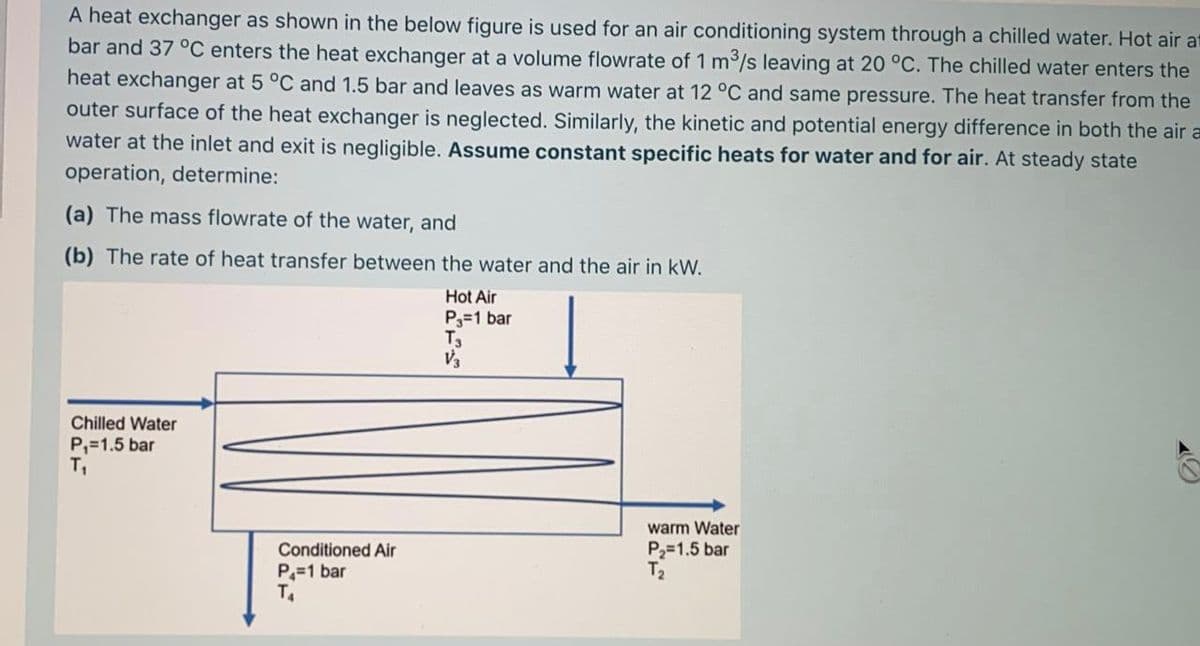A heat exchanger as shown in the below figure is used for an air conditioning system through a chilled water. Hot air at bar and 37 °C enters the heat exchanger at a volume flowrate of 1 m3/s leaving at 20 °C. The chilled water enters the heat exchanger at 5 °C and 1.5 bar and leaves as warm water at 12 °C and same pressure. The heat transfer from the outer surface of the heat exchanger is neglected. Similarly, the kinetic and potential energy difference in both the air a water at the inlet and exit is negligible. Assume constant specific heats for water and for air. At steady state operation, determine: (a) The mass flowrate of the water, and (b) The rate of heat transfer between the water and the air in kW.
A heat exchanger as shown in the below figure is used for an air conditioning system through a chilled water. Hot air at bar and 37 °C enters the heat exchanger at a volume flowrate of 1 m3/s leaving at 20 °C. The chilled water enters the heat exchanger at 5 °C and 1.5 bar and leaves as warm water at 12 °C and same pressure. The heat transfer from the outer surface of the heat exchanger is neglected. Similarly, the kinetic and potential energy difference in both the air a water at the inlet and exit is negligible. Assume constant specific heats for water and for air. At steady state operation, determine: (a) The mass flowrate of the water, and (b) The rate of heat transfer between the water and the air in kW.
Principles of Heat Transfer (Activate Learning with these NEW titles from Engineering!)
8th Edition
ISBN:9781305387102
Author:Kreith, Frank; Manglik, Raj M.
Publisher:Kreith, Frank; Manglik, Raj M.
Chapter6: Forced Convection Over Exterior Surfaces
Section: Chapter Questions
Problem 6.12P
Related questions
Concept explainers
Heat Exchangers
Heat exchangers are the types of equipment that are primarily employed to transfer the thermal energy from one fluid to another, provided that one of the fluids should be at a higher thermal energy content than the other fluid.
Heat Exchanger
The heat exchanger is a combination of two words ''Heat'' and ''Exchanger''. It is a mechanical device that is used to exchange heat energy between two fluids.
Question

Transcribed Image Text:A heat exchanger as shown in the below figure is used for an air conditioning system through a chilled water. Hot air at
bar and 37 °C enters the heat exchanger at a volume flowrate of 1 m3/s leaving at 20 °C. The chilled water enters the
heat exchanger at 5 °C and 1.5 bar and leaves as warm water at 12 °C and same pressure. The heat transfer from the
outer surface of the heat exchanger is neglected. Similarly, the kinetic and potential energy difference in both the air a
water at the inlet and exit is negligible. Assume constant specific heats for water and for air. At steady state
operation, determine:
(a) The mass flowrate of the water, and
(b) The rate of heat transfer between the water and the air in kW.
Hot Air
P3=1 bar
T3
V3
Chilled Water
P,=1.5 bar
T1
warm Water
P,=1.5 bar
T2
Conditioned Air
P=1 bar
Expert Solution
This question has been solved!
Explore an expertly crafted, step-by-step solution for a thorough understanding of key concepts.
Step by step
Solved in 2 steps with 2 images

Knowledge Booster
Learn more about
Need a deep-dive on the concept behind this application? Look no further. Learn more about this topic, mechanical-engineering and related others by exploring similar questions and additional content below.Recommended textbooks for you

Principles of Heat Transfer (Activate Learning wi…
Mechanical Engineering
ISBN:
9781305387102
Author:
Kreith, Frank; Manglik, Raj M.
Publisher:
Cengage Learning

Principles of Heat Transfer (Activate Learning wi…
Mechanical Engineering
ISBN:
9781305387102
Author:
Kreith, Frank; Manglik, Raj M.
Publisher:
Cengage Learning